Establishment of a basis for administrative use of PestSurf
Annex 5
5 Comparison of risk assessment data produced by spray drift assessments, FOCUS SW and PestSurf
5.1 Chemical characteristics of the compound
| Compound: | Malathion |
| Dose: | 880 g ai/ha |
| Spraying time: | 15. june |
| Crop: | Peas |
Table 5.1. Overview of chemical properties of malathion and the parameters used in the simulations.
Tabel 5.1. Oversigt over malathions kemiske egenskaber og parametrene brugt i simuleringerne.
| Chemical property | Condition | Recalculated values | |||
| Cas-no. | 121-75-5 | ||||
| Molecular weight | 330.36 | ||||
| Form (acid, basic, neutral) | neutral | ||||
| pKa | |||||
| Water solubility | 148 µg/l | (unbuffered solution) | 25°C | ||
| log Kow | at pH | KowA- | |||
| log Kow | 2.75 | at pH | KowAH | 2.75 | |
| log Kow | at pH | KowAH+ | |||
| Vapor pressure, Pa | 4.5 × 10-4 | 25°C | 3.10 × 10-3 Pa at 35°C | vapor pressure, Pa, 20°C | 1.63 × 10-4 |
| Henry’s law constant | 1.0 × 10-3 Pa m³ mol-1 | Recalculated value, dimensionless | 4.11 × 10-7 | ||
| Sorption properties in soil | |||||
| Freundlich exp | 1 | ||||
| Koc, l/kg | 209 | ||||
| DT50 in soil, days | 0.133 | ||||
| DT50water | 9 hours | PestSurf input | |||
| DT50sedment | None mentioned | ||||
| DT50water/sediment | 9 hours | method not described | DT50, days | 0.375 | |
| Sediment konc., µg/l | 80 (default in PestSurf) | ||||
| Hydrolysis | 107 | at pH 5 | (acid) | indef | |
| 6.21 | at pH 7 | (neutral) | 10.2 | ||
| 0.49 | at pH 9 | (basic) | 5.7 × 10-6 | ||
| Photolysis | |||||
| quantum yield | No absorbance above 290 nm, set to 0 | ||||
| Spectrum | No absorbance above 290 nm | ||||
| Other | |||||
5.2 Concentration generated by spray
| Direct spray | FOCUS buffer zones | |||
| mg/l | ditch | Stream | Pond | |
| µg l-1 | µg l-1 | µg l-1 | µg l-1 | |
| Malathion | 293.3 | 6.262 | 4.556 | 2.194 |
5.3 Concentrations generated by FOCUS SW
5.3.1 D3- Ditch
| Malathion | Ditch, D3 | |||||||
| Water | Sediment | |||||||
| Date | PEC | Date | TWAEC | Date | PEC | Date | TWAEC | |
| µg l-1 | µg l-1 | µg kg-1 | µg kg-1 | |||||
| Global max | 21-jun-92 | 4.612 | 21-jun-92 | 0.469 | ||||
| 1 d | 22-jun-92 | 0.568 | 22-jun-92 | 2.117 | 22-jun-92 | 0.149 | 22-jun-92 | 0.382 |
| 2 d | 23-jun-92 | 0.022 | 23-jun-92 | 1.155 | 23-jun-92 | 0.025 | 23-jun-92 | 0.253 |
| 4 d | 25-jun-92 | 0 | 25-jun-92 | 0.579 | 25-jun-92 | 0.001 | 25-jun-92 | 0.133 |
| 7 d | 28-jun-92 | 0 | 27-jun-92 | 0.331 | 28-jun-92 | 0 | 28-jun-92 | 0.076 |
5.3.2 D4 – Stream
| Malathion | Stream, D4 | |||||||
| Water | Sediment | |||||||
| Date | PEC | Date | TWAEC | Date | PEC | Date | TWAEC | |
| µg l-1 | µg l-1 | µg kg-1 | µg kg-1 | |||||
| Global max | 18-jun-85 | 3.922 | 18-jun-85 | 0.168 | ||||
| 1 d | 19-jun-85 | 0 | 19-jun-85 | 0.314 | 19-jun-85 | 0.016 | 19-jun-85 | 0.067 |
| 2 d | 20-jun-85 | 0 | 20-jun-85 | 0.157 | 20-jun-85 | 0.004 | 20-jun-85 | 0.038 |
| 4 d | 22-jun-85 | 0 | 22-jun-85 | 0.078 | 22-jun-85 | 0 | 22-jun-85 | 0.02 |
| 7 d | 25-jun-85 | 0 | 22-jun-85 | 0.045 | 25-jun-85 | 0 | 25-jun-85 | 0.011 |
5.3.3 D4 – Pond
| Malathion | Pond, D4 | |||||||
| Water | Sediment | |||||||
| Date | PEC | Date | TWAEC | Date | PEC | Date | TWAEC | |
| µg l-1 | µg l-1 | µg kg-1 | µg kg-1 | |||||
| Global max | 18-jun-85 | 0.187 | 18-jun-85 | 0.024 | ||||
| 1 d | 19-jun-85 | 0.059 | 19-jun-85 | 0.111 | 19-jun-85 | 0.013 | 19-jun-85 | 0.021 |
| 2 d | 20-jun-85 | 0.019 | 20-jun-85 | 0.074 | 20-jun-85 | 0.006 | 20-jun-85 | 0.017 |
| 4 d | 22-jun-85 | 0.002 | 22-jun-85 | 0.041 | 22-jun-85 | 0.001 | 22-jun-85 | 0.011 |
| 7 d | 25-jun-85 | 0 | 25-jun-85 | 0.024 | 25-jun-85 | 0 | 25-jun-85 | 0.006 |
5.3.4 Conclusion – FOCUS SW
The highest concentration is generated in the ditch (D3). It is caused by wind drift and the concentration becomes 4.6 µg/l. The same scenario shows the highest concentration in the sediment, 0.469 µg/kg. For all scenarios, the concentrations are lower than what is generated by the simpler assessments.
5.4 PestSurf
5.4.1 Sandy Catchment, stream
The distribution of concentrations was assessed in several steps. First, the maximum concentrations at each calculation point were listed, and the dates for the occurrence of the maximum were assessed. The points, for which the maximum value also represents a local maximum, were selected for further analysis. The relevant values are listed in Table 5.2.
Table 5.2. Maximum concentrations (ng/l) of malathion simulated for each calculation point in the sandy catchment.
Tabel 5.2. Maximumkoncentrationer (ng/l) af malathion simuleret for hvert beregningspunkt i det sandede opland.
| MALATHION | Maximum | Max.Time | Local maxima |
| ODDERBAEK 0.00 | 1534 | 15-06-1998 09:19 | |
| ODDERBAEK 56.00 | 1637 | 15-06-1998 09:10 | |
| ODDERBAEK 112.00 | 1961 | 15-06-1998 09:00 | |
| ODDERBAEK 192.00 | 4252 | 15-06-1998 08:40 | |
| ODDERBAEK 272.00 | 6613 | 15-06-1998 08:30 | |
| ODDERBAEK 278.00 | 7021 | 15-06-1998 08:30 | |
| ODDERBAEK 282.00 | 7298 | 15-06-1998 08:30 | |
| ODDERBAEK 298.50 | 8112 | 15-06-1998 08:30 | |
| ODDERBAEK 315.00 | 8949 | 15-06-1998 08:30 | |
| ODDERBAEK 317.50 | 9074 | 15-06-1998 08:30 | |
| ODDERBAEK 320.00 | 9186 | 15-06-1998 08:30 | |
| ODDERBAEK 410.00 | 11981 | 15-06-1998 08:30 | |
| ODDERBAEK 500.00 | 13374 | 15-06-1998 08:30 | |
| ODDERBAEK 513.00 | 14000 | 15-06-1998 08:30 | |
| ODDERBAEK 521.00 | 14415 | 15-06-1998 08:30 | |
| ODDERBAEK 622.00 | 16936 | 15-06-1998 08:30 | |
| ODDERBAEK 723.00 | 18768 | 15-06-1998 08:30 | |
| ODDERBAEK 733.00 | 19278 | 15-06-1998 08:30 | |
| ODDERBAEK 742.00 | 19561 | 15-06-1998 08:30 | |
| ODDERBAEK 789.50 | 20474 | 15-06-1998 08:30 | |
| ODDERBAEK 837.00 | 21400 | 15-06-1998 08:30 | |
| ODDERBAEK 848.00 | 21798 | 15-06-1998 08:30 | |
| ODDERBAEK 863.00 | 22308 | 15-06-1998 08:30 | |
| ODDERBAEK 956.00 | 24019 | 15-06-1998 08:30 | |
| ODDERBAEK 1049.00 | 24432 | 15-06-1998 08:30 | x |
| ODDERBAEK 1111.50 | 23356 | 15-06-2005 08:30 | |
| ODDERBAEK 1174.00 | 20906 | 15-06-2005 08:30 | |
| ODDERBAEK 1226.00 | 19680 | 15-06-2005 08:40 | |
| ODDERBAEK 1278.00 | 19138 | 15-06-2005 08:40 | |
| ODDERBAEK 1293.50 | 18893 | 15-06-2005 08:40 | |
| ODDERBAEK 1310.00 | 18503 | 15-06-2005 08:49 | |
| ODDERBAEK 1421.00 | 17821 | 17-06-2000 08:50 | |
| ODDERBAEK 1532.00 | 15696 | 15-06-1998 08:30 | |
| ODDERBAEK 1558.06 | 13932 | 15-06-1998 08:40 | |
| ODDERBAEK 1584.12 | 13342 | 15-06-1998 08:40 | |
| ODDERBAEK 1584.12 | 13342 | 15-06-1998 08:40 | |
| ODDERBAEK 1621.06 | 13308 | 15-06-1998 08:40 | |
| ODDERBAEK 1658.00 | 13608 | 15-06-1998 08:30 | |
| ODDERBAEK 1698.50 | 14525 | 15-06-1998 08:30 | |
| ODDERBAEK 1739.00 | 15205 | 15-06-1998 08:30 | x |
| ODDERBAEK 1801.50 | 14896 | 15-06-1998 08:30 | |
| ODDERBAEK 1864.00 | 12162 | 17-06-2004 08:30 | |
| ODDERBAEK 1977.00 | 9226 | 17-06-2000 10:00 | |
| ODDERBAEK 2090.00 | 9058 | 17-06-2000 10:00 | |
| ODDERBAEK 2098.00 | 9051 | 17-06-2000 10:00 | |
| ODDERBAEK 2105.00 | 9027 | 17-06-2000 10:00 | |
| ODDERBAEK 2131.00 | 8968 | 17-06-2000 10:00 | |
| ODDERBAEK 2157.00 | 8865 | 17-06-2000 10:00 | |
| ODDERBAEK 2168.00 | 8818 | 17-06-2000 10:00 | |
| ODDERBAEK 2179.00 | 8775 | 17-06-2000 10:00 | |
| ODDERBAEK 2268.50 | 8633 | 17-06-2000 10:00 | |
| ODDERBAEK 2358.00 | 8185 | 17-06-2004 10:00 | |
| ODDERBAEK 2363.50 | 8149 | 17-06-2004 10:00 | |
| ODDERBAEK 2372.00 | 8107 | 17-06-2004 10:00 | |
| ODDERBAEK 2427.00 | 7999 | 17-06-2004 10:00 | |
| ODDERBAEK 2482.00 | 7877 | 15-06-2001 11:00 | |
| ODDERBAEK 2609.00 | 7921 | 17-06-2000 11:00 | |
| ODDERBAEK 2736.00 | 7505 | 17-06-2000 11:00 | |
| ODDERBAEK 2831.00 | 7445 | 17-06-2000 11:00 | |
| ODDERBAEK 2926.00 | 6991 | 17-06-2000 11:00 | |
| ODDERBAEK 2958.50 | 6905 | 17-06-2000 11:00 | |
| ODDERBAEK 2991.00 | 6813 | 17-06-2004 11:00 | |
| ODDERBAEK 3029.50 | 6615 | 17-06-2004 11:00 | |
| ODDERBAEK 3068.00 | 6262 | 17-06-2004 11:00 | |
| ODDERBAEK 3131.00 | 5830 | 17-06-2004 11:00 | |
| ODDERBAEK 3194.00 | 5581 | 17-06-2000 12:00 | |
| ODDERBAEK 3250.50 | 5543 | 17-06-2000 12:00 | |
| ODDERBAEK 3307.00 | 5498 | 17-06-2004 12:00 | |
| ODDERBAEK 3315.00 | 5496 | 17-06-2004 12:00 | |
| ODDERBAEK 3323.00 | 5489 | 17-06-2004 12:00 | |
| ODDERBAEK 3355.50 | 6305 | 15-06-1998 08:30 | |
| ODDERBAEK 3388.00 | 7186 | 15-06-1998 08:30 | |
| ODDERBAEK 3438.50 | 8072 | 15-06-1998 08:30 | |
| ODDERBAEK 3489.00 | 8338 | 15-06-1998 08:30 | |
| ODDERBAEK 3499.50 | 8370 | 15-06-1998 08:30 | x |
| ODDERBAEK 3510.00 | 8354 | 15-06-1998 08:30 | |
| ODDERBAEK 3581.00 | 7612 | 15-06-1998 08:30 | |
| ODDERBAEK 3652.00 | 6726 | 15-06-1998 08:40 | |
| ODDERBAEK 3707.00 | 6731 | 15-06-1998 08:40 | |
| ODDERBAEK 3762.00 | 6201 | 15-06-1998 08:40 | |
| ODDERBAEK 3790.00 | 5436 | 15-06-1998 08:40 | |
| ODDERBAEK 3818.00 | 4301 | 15-06-1998 08:40 | |
| ODDERBAEK 3818.00 | 4301 | 15-06-1998 08:40 | |
| ODDERBAEK 3884.00 | 4192 | 15-06-1998 08:49 | |
| ODDERBAEK 3950.00 | 4010 | 15-06-1998 08:49 | |
| ODDERBAEK 3998.00 | 3738 | 15-06-1998 08:49 | |
| ODDERBAEK 4046.00 | 3541 | 15-06-1998 09:00 | |
| ODDERBAEK 4047.50 | 3539 | 15-06-1998 09:00 | |
| ODDERBAEK 4049.00 | 3538 | 15-06-1998 09:00 | |
| ODDERBAEK 4052.50 | 3537 | 15-06-1998 09:00 | |
| ODDERBAEK 4056.00 | 3535 | 15-06-1998 09:00 | |
| ODDERBAEK 4058.00 | 3533 | 15-06-1998 09:00 | |
| ODDERBAEK 4060.00 | 3531 | 15-06-1998 09:00 | |
| ODDERBAEK 4080.00 | 3500 | 15-06-1998 09:00 | |
| ODDERBAEK 4100.00 | 3471 | 15-06-1998 09:00 | |
| ODDERBAEK 4134.00 | 3480 | 15-06-2005 09:00 | |
| ODDERBAEK 4168.00 | 3486 | 15-06-2005 09:00 | |
| GISLUM_ENGE_AFLOEB 0.00 | 0 | 15-06-1998 08:10 | |
| GISLUM_ENGE_AFLOEB 50.00 | 0 | 15-06-1998 08:10 | |
| GISLUM_ENGE_AFLOEB 100.00 | 0 | 15-06-1998 08:10 | |
| GISLUM_ENGE_AFLOEB 150.00 | 0 | 15-06-1998 08:10 | |
| GISLUM_ENGE_AFLOEB 200.00 | 0 | 15-06-1998 08:10 | |
| GISLUM_ENGE_AFLOEB 250.00 | 0 | 15-06-1998 08:10 | |
| GISLUM_ENGE_AFLOEB 300.00 | 0 | 15-06-1998 08:10 | |
| GISLUM_ENGE_AFLOEB 340.00 | 0 | 15-06-1998 08:10 | |
| GISLUM_ENGE_AFLOEB 380.00 | 0 | 15-06-1998 08:10 | |
| GISLUM_ENGE_AFLOEB 430.00 | 0 | 15-06-1998 08:10 | |
| GISLUM_ENGE_AFLOEB 480.00 | 0 | 15-06-1998 08:10 | |
| GISLUM_ENGE_AFLOEB 530.00 | 0 | 15-06-1998 08:10 | |
| GISLUM_ENGE_AFLOEB 580.00 | 0 | 15-06-1998 08:10 | |
| GISLUM_ENGE_AFLOEB 630.00 | 0 | 15-06-1998 08:10 | |
| GISLUM_ENGE_AFLOEB 680.00 | 0 | 15-06-1998 08:10 | |
| GISLUM_ENGE_AFLOEB 730.00 | 0 | 15-06-1998 09:10 | |
| GISLUM_ENGE_AFLOEB 780.00 | 0 | 15-06-1998 09:10 | |
| GISLUM_ENGE_AFLOEB 830.00 | 0 | 15-06-1998 09:10 | |
| GISLUM_ENGE_AFLOEB 880.00 | 0 | 15-06-1998 09:10 | |
| GISLUM_ENGE_AFLOEB 915.00 | 0 | 15-06-1998 09:10 | |
| GISLUM_ENGE_AFLOEB 950.00 | 0 | 15-06-1998 09:10 | |
| GISLUM_ENGE_AFLOEB 985.00 | 0 | 15-06-1998 09:00 | |
| GISLUM_ENGE_AFLOEB 1020.00 | 0 | 15-06-1998 09:00 | |
| GISLUM_ENGE_AFLOEB 1045.00 | 0 | 15-06-1998 09:00 | |
| GISLUM_ENGE_AFLOEB 1070.00 | 0 | 15-06-1998 09:00 | |
| GISLUM_ENGE_AFLOEB 1110.00 | 0 | 15-06-1998 09:00 | |
| GISLUM_ENGE_AFLOEB 1150.00 | 1 | 15-06-1998 09:00 | |
| GISLUM_ENGE_AFLOEB 1190.00 | 3 | 15-06-1998 09:00 | |
| GISLUM_ENGE_AFLOEB 1230.00 | 7 | 15-06-1998 09:00 | |
| GISLUM_ENGE_AFLOEB 1271.00 | 24 | 15-06-1998 08:49 | |
| GISLUM_ENGE_AFLOEB 1312.00 | 72 | 15-06-1998 08:49 | |
| GISLUM_ENGE_AFLOEB 1422.00 | 858 | 15-06-1998 08:49 | |
| GISLUM_ENGE_AFLOEB 1532.00 | 4301 | 15-06-1998 08:40 | |
| TILLOEB 0.00 | 12836 | 15-06-1998 08:40 | |
| TILLOEB 20.16 | 13138 | 15-06-1998 08:40 | |
| TILLOEB 40.31 | 13342 | 15-06-1998 08:40 | |
| global max | 24432 |
The pattern over time was the same for all calculation points. The peak values are generated by wind drift, see Figure 5.1.
Each of the events generated an almost identical pattern along the stream; see the longitudinal profile in Figure 5.2. The thin black line represents the concentration, while the thick black line shows the maximum concentrations obtained during the simulations. In addition, the outline of the stream is shown. In the middle of the catchment, the stream is protected by unsprayed areas. The maximum values at the center of the catchment are obtained when the peak from upstream move through the catchment during the hour following spraying.
In order to present the data in a similar fashion to the FOCUS SW-results, data were extracted and recalculated for the time series marked in Table 5.2. The global maxima and time weighted concentrations (up to 7 days) were extracted and are reported in Table 5.3. Note that the unit is ng/l.
The highest concentration of malathion on macrophytes (343 ng/l) is shown in Figure 5.3. It has a limited influence on the concentration in the water phase. The maximum pore water concentration is shown in Figure 5.4. The sediment concentration is 2.9 ng/kg.
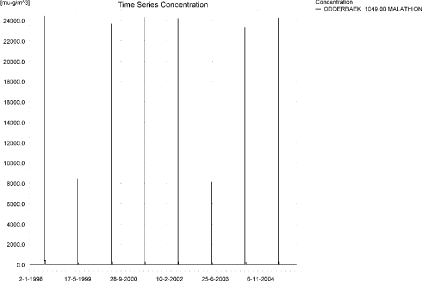
Figure 5.1. Concentration pattern over time for malathion in the sandy catchment.
Figur 5.1. Koncentrationsmønster som funktion af tid for malathion i det sandede opland.
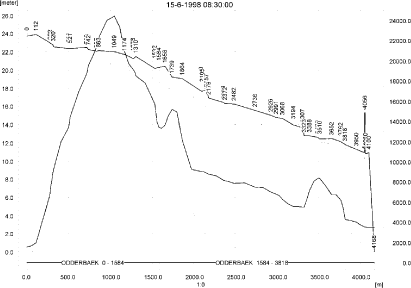
Figure 5.2. Concentrations of malathion in the sandy catchment on 15. June, 1998 after spraying.
Figur 5.2. Koncentrationer malathion i det sandede opland den 15. juni 1998 lige efter endt sprøjtning.
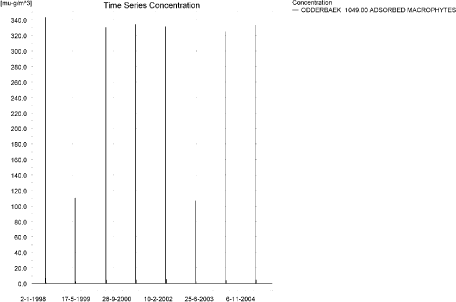
Figure 5.3. The concentration of malathion sorbed on macrophytes.
Figur 5.3. Koncentration af malathion sorberet på makrofytter.
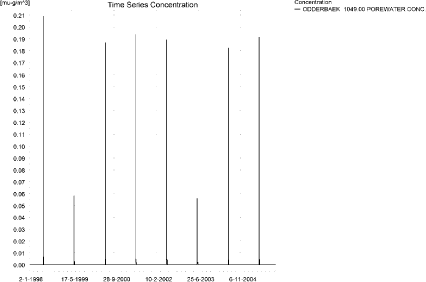
Figure 5.4. Pore water concentrations of malathion in the sandy catchment.
Figur 5.4. Porevandskoncentration for malathion i det sandede opland.
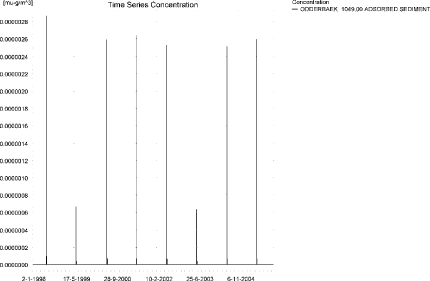
Figure 5.5. Sediment concentrations of malathion in the sandy catchment. Note that the unit is in µg/g instead of µg/m³ as indicated.
Figur 5.5. Sedimentkoncentration for malathion i det sandede opland. Bemærk at koncentrationen er i µg/g og ikke i µg/m³ som angivet.
The global maximum value calculated by PestSurf for the sandy catchment in the water phase is 24.4 µg/l. This is considerably higher than what is found in the D3-ditch scenario (4.61 µg/l). A small amount of pesticide was sorbed to macrophytes (0.343 µg/l) in the stream. The high concentration is caused by the long stretch of stream that is sprayed simultaneously. A more comparable value could be the concentration 112 m from the upstream end. Here drift causes a concentration of 1.96 µg/l.
Table 5.3. Concentration (ng/l)of malathion at selected points in the sandy stream.
Tabel 5.3. Koncentration af malathion, ng/l, på udvalgte lokaliteter i det sandede vandløb.
Figure 5.6. Overview for malathion in the sandy catchment generated by the PestSurf excel template. The max concentrations generated over the 24 hours are similar to the overview in Figure 5.2. The graph to the lower right shows how many events have concentrations higher than a given value for the selected monitoring points. Detection value was set to 10 ng/l.
Figur 5.6. Oversigt for malathion i det sandede opland genereret med PestSurf-excel-skabelonen. Den maximale koncentration genereret over 24 timer svarer til oversigten i Figur 5.2. Grafen nederst til højre viser hvor mange hændelser, der har koncentrationer højere end en given værdi i et udvalgt punkt. Detektionsgrænsen var sat til 10 ng/l.
Table 5.4. Part of the result sheet generated by the PestSurf Excel sheet. The selected table shows the point along the stream with the highest concentration recorded. The detection values applied in the table is 10 ng/l, toxicity to fish, daphnies and algae are set to 100, 1000 and 10000 ng/, respectively. The recorded peaks are shown in Figure 5.6.
Tabel 5.4. Uddrag af resultatpresentationen genereret af PestSurf-Excel-arket. Den udvalgte tabel viser det fordefinerede punkt langs med åen med højest koncentration. Detektionsgrænsen er sat til 10 mens toxicitetsværdierne for fisk, dafnier og alger er henholdsvis 100, 1000 og 10000 ng/l. De tabellerede hændelser er vist i Figur 5.6.
Figure 5.6 and Table 5.4 show the output of the PestSurf Excel template. The template works with pre-defined data extraction points. The plot requires specification of a “lowest detection value” (ldc) which defines when a pesticide occurrence is defined as an event. The time series plot is identical to the time series shown earlier, and the graph in the upper right corner resembles the plots in Figure 5.2, but takes into account a longer period of time. A curve is generated when a downstream point reaches a concentration higher than the ldc. The programme then tracks the highest concentration for each calculation point in the stream within the last 24 hours. The plot in the lower right corner shows how many events have concentrations higher than a given value for the selected monitoring points. Table 5.4 shows the table representing the point along the stream (of the pre-defined points) with the highest concentration. This value was, however, only 13.3 µg/l. Thus, the pre-defined points have not caught the highest concentration of the simulation, which was 24.4 µg/l.
5.4.2 Sandy Catchment, pond
The concentration pattern is evaluated in the middle of the pond only, see Figure 5.7. The pond receives drift and in 1999 and 2003 a contribution from groundwater, due to rainfall in the beginning of July. The drift peaks are visible in all years. The maximum concentration is 188 ng/l.
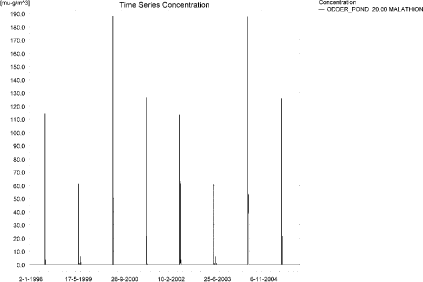
Figure 5.7. Concentrations of malathion in the sandy pond.
Figur 5.7. Koncentration af malathion i det sandede vandhul.
In Table 5.5, global maxima and time weighted concentrations (up to 7 days) were extracted.
Table 5.5. Maximum concentrations (ng/l) of malathion generated by drift for the sandy pond.
Tabel 5.5. maximumkoncentrationer af malathion(ng/l) genereret for det sandede vandhul.
| Year | ODDER_POND 20.00 | |||
| Conc. | TWC | Date | ||
| 1998 | 1998 (global max) | 114 | 15-06-1998 | |
| 1 hour (after max) | 81 | 86 | ||
| 1 day after sp.in. | 17 | 45 | ||
| 2 days | 1 | 17 | ||
| 4 days | 1 | 13 | ||
| 7 days | 3 | 8 | ||
| 1999 | 1999 (global max) | 61 | 15-06-1999 | |
| 1 hour (after max) | 40 | 44 | ||
| 1 day after sp.in. | 1 | 9 | ||
| 2 days | 1 | 3 | ||
| 4 days | 1 | 3 | ||
| 7 days | 1 | 2 | ||
| 2000 | 2000 (global max) | 188 | 17-06-2000 | |
| 1 hour (after max) | 144 | 152 | ||
| 1 day after sp.in. | 63 | 95 | ||
| 2 days | 44 | 64 | ||
| 4 days | 46 | 59 | ||
| 7 days | 51 | 54 | ||
| 2001 | 2001 (global max) | 126 | 15-06-2001 | |
| 1 hour (after max) | 90 | 96 | ||
| 1 day after sp.in. | 30 | 55 | ||
| 2 days | 11 | 29 | ||
| 4 days | 13 | 25 | ||
| 7 days | 21 | 22 | ||
| 2002 | 2002 (global max) | 114 | 15-06-2002 | |
| 1 hour (after max) | 81 | 86 | ||
| 1 day after sp.in. | 17 | 45 | ||
| 2 days | 1 | 17 | ||
| 4 days | 1 | 13 | ||
| 7 days | 3 | 8 | ||
| 2003 | 2003 (global max) | 61 | 15-06-2003 | |
| 1 hour (after max) | 40 | 44 | ||
| 1 day after sp.in. | 1 | 9 | ||
| 2 days | 1 | 3 | ||
| 4 days | 1 | 3 | ||
| 7 days | 1 | 2 | ||
| 2004 | 2004 (global max) | 187 | 17-06-2004 | |
| 1 hour (after max) | 144 | 151 | ||
| 1 day after sp.in. | 63 | 95 | ||
| 2 days | 44 | 64 | ||
| 4 days | 46 | 59 | ||
| 7 days | 51 | 54 | ||
| 2005 | 2005 (global max) | 126 | 15-06-2005 | |
| 1 hour (after max) | 90 | 96 | ||
| 1 day after sp.in. | 30 | 55 | ||
| 2 days | 11 | 29 | ||
| 4 days | 13 | 25 | ||
| 7 days | 21 | 22 | ||
| Global max | 188 | |||
| 1 hour (after max) | 144 | 152 | ||
| 1 day after sp.in. | 63 | 95 | ||
| 2 days | 44 | 64 | ||
| 4 days | 46 | 59 | ||
| 7 days | 51 | 54 | ||
As for the previous simulation, some sorption to the macrophytes is observed, see Figure 5.8. The concentration is quite small, with a maximum of 0.301 ng/l. The max. concentrations reached for pore water is 0.003 ng/l (see Figure 5.9) and the concentration of malathion adsorbed to sediment is<0.01 ng/kg.
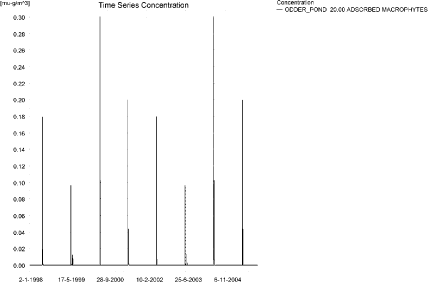
Figure 5.8. Sorption of malathion to macrophytes in the sandy pond.
Figur 5.8. Sorption af malathion til makrofytter i det sandede vandhul.
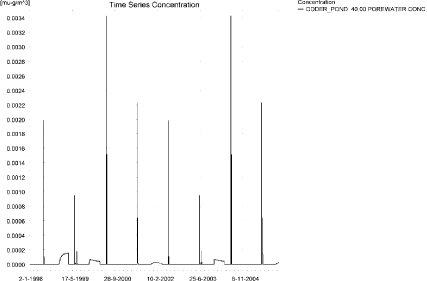
Figure 5.9. Pore water concentration of malathion in the sandy pond.
Figur 5.9. Porevandskoncentration af malathion i det sandede vandhul.
Compared to the FOCUS D3 ditch, the concentration in the PestSurf sandy pond is considerably lower, 0.188 µg/l compared to 4.61 µg/l. Wind drift is significant in both cases. The dilution is far greater in the pond than in the ditch.
In the pond-case, there is no difference between the results of Pestsurf and the results extracted by the templates.
Figure 5.10 shows the output of the PestSurf Excel template. The template works with one pre-defined data extraction point for the pond (center of the pond). The plot requires specification of a “lowest detection value” (ldc) which defines when a pesticide occurrence is defined as an event. The time series plot is identical to the time series shown earlier. The plot to the right shows how many events have concentrations higher than a given toxicity value for the selected monitoring points.
Table 5.6 shows part of the result sheet generated by the PestSurf Excel sheet based on the ldc-value.
Click here to see Figure 5.10.
Figure 5.10. Overview for malathion in the sandy pond generated by the PestSurf excel template. The time series shown is identical to the one in Figure 5.7. The detection value is set to 1 ng/l.
Figur 5.10. Oversigt for malathion i det sandede vandhul genereret med PestSurf-excel-skabelonen. Den viste tidsserie er mage til den i Figur 5.7. Detektionsgrænsen er sat til 1 ng/l.
Table 5.6. Part of the result sheet generated by the PestSurf Excel sheet, applied to malathion. The limiting values applied for table generation is 1 ng/l, toxicity to fish, daphnies and algae are set to 10, 50 and 100 ng/, respectively. The recorded peaks are shown in Figure 5.10.
Tabel 5.6. Uddrag af resultatpresentationen genereret af PestSurf-Excel-arket anvendt på malathion. Grænseværdien anvendt til tabelgenerering er sat til 1 ng/l mens toxicitetsværdierne for fisk, dafnier og alger er henholdsvis 10, 50 og 100 ng/l. De tabellerede hændelser er vist i Figur 5.10.
5.4.3 Sandy Loam catchment, Stream
The distribution of concentrations was assessed in several steps. First, the maximum concentrations at each calculation point were listed in Table 5.7, and the dates for the occurrence of the maximum were assessed. The points, for which the maximum value also represents a local maximum, were selected for further analysis.
All points show the same type of time series pattern. The six points with highest maximum values were analyzed further.
Table 5.7. Maximum concentrations (ng/l) of malathion simulated for each calculation point in the sandy loam catchment.
Tabel 5.7. Maximumskoncentrationer (ng/l) af malathion simuleret for hvert beregningspunkt i morænelersoplandet.
| MALATHION | Maximum | Max.Time | Local Maxima |
| ALBJERGBAEK 0.00 | 0 | 14-06-1998 11:00 | |
| ALBJERGBAEK 150.00 | 0 | 26-06-1996 01:00 | |
| ALBJERGBAEK 300.00 | 8 | 14-06-1998 10:00 | |
| ALBJERGBAEK 450.00 | 0 | 24-06-1996 21:00 | |
| ALBJERGBAEK 600.00 | 18021 | 14-06-2000 13:00 | |
| ELHOLTBAEK 0.00 | 17 | 14-06-2001 09:30 | |
| ELHOLTBAEK 165.00 | 0 | 03-02-1999 00:00 | |
| ELHOLTBAEK 330.00 | 14707 | 14-06-2000 08:49 | |
| FREDLIGBAEK 0.00 | 0 | 15-06-2000 05:00 | |
| FREDLIGBAEK 100.00 | 0 | 09-07-1996 08:00 | |
| FREDLIGBAEK 200.00 | 0 | 14-06-1998 13:00 | |
| FREDLIGBAEK 300.00 | 0 | 12-07-2000 18:00 | |
| FREDLIGBAEK 400.00 | 0 | 14-06-1998 11:00 | |
| FREDLIGBAEK 500.00 | 0 | 13-07-1996 21:00 | |
| FREDLIGBAEK 600.00 | 5 | 14-06-1998 09:49 | |
| FREDLIGBAEK 667.50 | 0 | 13-10-2000 00:00 | |
| FREDLIGBAEK 735.00 | 27893 | 14-06-2000 09:40 | |
| GROFTEBAEK 0.00 | 0 | 14-06-1998 09:30 | |
| GROFTEBAEK 155.00 | 0 | 23-06-2001 16:00 | |
| GROFTEBAEK 310.00 | 32 | 14-06-1998 09:19 | |
| GROFTEBAEK 465.00 | 0 | 13-07-1997 14:00 | |
| GROFTEBAEK 620.00 | 36543 | 14-06-2000 08:49 | |
| STENSBAEK 0.00 | 0 | 14-06-1999 11:00 | |
| STENSBAEK 125.00 | 0 | 05-02-2000 00:00 | |
| STENSBAEK 250.00 | 6 | 14-06-1999 09:49 | |
| STENSBAEK 412.50 | 0 | 25-06-1996 04:00 | |
| STENSBAEK 575.00 | 10153 | 14-06-2000 14:00 | |
| OVRELILLEBAEK 0.00 | 0 | 24-06-2000 16:00 | |
| OVRELILLEBAEK 125.00 | 31296 | 14-06-1999 08:30 | |
| OVRELILLEBAEK 250.00 | 32998 | 14-06-2000 08:30 | |
| OVRELILLEBAEK 290.00 | 42364 | 14-06-2000 11:00 | x |
| OVRELILLEBAEK 330.00 | 18021 | 14-06-2000 13:00 | |
| OVRELILLEBAEK 330.00 | 18021 | 14-06-2000 13:00 | |
| OVRELILLEBAEK 352.50 | 23542 | 14-06-2000 13:00 | |
| OVRELILLEBAEK 375.00 | 10153 | 14-06-2000 14:00 | |
| OVRELILLEBAEK 375.00 | 10153 | 14-06-2000 14:00 | |
| OVRELILLEBAEK 437.50 | 18582 | 14-06-2000 08:30 | |
| OVRELILLEBAEK 500.00 | 30198 | 14-06-2000 08:30 | |
| OVRELILLEBAEK 625.00 | 34979 | 14-06-2000 08:40 | x |
| OVRELILLEBAEK 750.00 | 22170 | 14-06-2000 08:30 | |
| OVRELILLEBAEK 855.00 | 32734 | 14-06-2000 08:30 | |
| OVRELILLEBAEK 960.00 | 14707 | 14-06-2000 08:49 | |
| OVRELILLEBAEK 960.00 | 14707 | 14-06-2000 08:49 | |
| OVRELILLEBAEK 980.00 | 16106 | 14-06-2000 08:49 | |
| OVRELILLEBAEK 1000.00 | 12997 | 14-06-2000 08:49 | |
| OVRELILLEBAEK 1062.50 | 12443 | 14-06-2000 09:00 | |
| OVRELILLEBAEK 1125.00 | 16217 | 14-06-2000 08:30 | |
| OVRELILLEBAEK 1187.50 | 21491 | 14-06-2000 08:30 | |
| OVRELILLEBAEK 1250.00 | 23751 | 14-06-2000 08:30 | |
| OVRELILLEBAEK 1425.00 | 29939 | 14-06-2000 08:30 | x |
| OVRELILLEBAEK 1600.00 | 23282 | 14-06-2000 08:30 | |
| OVRELILLEBAEK 1650.00 | 30058 | 14-06-2000 08:30 | x |
| OVRELILLEBAEK 1700.00 | 17277 | 14-06-2000 09:10 | |
| NEDRELILLEBAEK 0.00 | 17277 | 14-06-2000 09:10 | |
| NEDRELILLEBAEK 135.00 | 17815 | 14-06-2000 08:30 | |
| NEDRELILLEBAEK 270.00 | 30583 | 14-06-2000 08:30 | |
| NEDRELILLEBAEK 330.00 | 36673 | 14-06-2000 08:30 | x |
| NEDRELILLEBAEK 390.00 | 33922 | 14-06-2000 08:30 | |
| NEDRELILLEBAEK 495.50 | 39321 | 14-06-2001 08:40 | x |
| NEDRELILLEBAEK 601.00 | 27893 | 14-06-2000 09:40 | |
| NEDRELILLEBAEK 601.00 | 27893 | 14-06-2000 09:40 | |
| NEDRELILLEBAEK 693.00 | 26782 | 14-06-2000 10:00 | |
| NEDRELILLEBAEK 785.00 | 40952 | 14-06-2000 08:30 | |
| NEDRELILLEBAEK 847.00 | 60968 | 14-06-2000 08:30 | x |
| NEDRELILLEBAEK 909.00 | 36543 | 14-06-2000 08:49 | |
| NEDRELILLEBAEK 909.00 | 36543 | 14-06-2000 08:49 | |
| NEDRELILLEBAEK 984.50 | 32758 | 14-06-2000 09:00 | |
| NEDRELILLEBAEK 1060.00 | 47113 | 14-06-2000 08:30 | |
| NEDRELILLEBAEK 1169.50 | 58727 | 14-06-2000 08:30 | |
| NEDRELILLEBAEK 1279.00 | 81412 | 14-06-2000 08:30 | x |
| NEDRELILLEBAEK 1409.50 | 38697 | 14-06-2001 09:10 | |
| NEDRELILLEBAEK 1540.00 | 25571 | 14-06-2001 11:00 | |
| global max | 81412 |
All maximum concentrations are caused by drift. Figure 5.11 and Figure 5.12 show the concentration pattern as it appears for the whole stream.
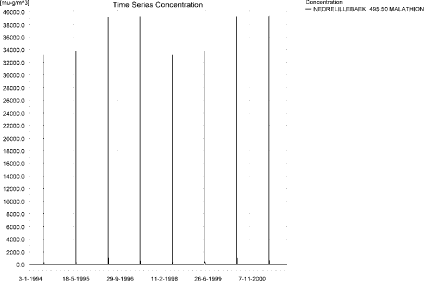
Figure 5.11. Concentration pattern for malathion in the sandy loam catchment.
Figur 5.11. Koncentrationsmønster for malathion i morænelersoplandet.
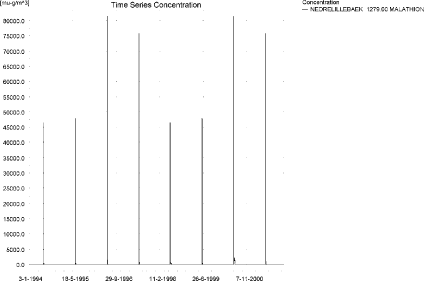
Figure 5.12. Concentration pattern for malathion in the sandy loam catchment.
Figur 5.12. Koncentrationsmønster for malathion i morænelersoplandet.
Longitudinal profiles of the concentrations in the sandy loam catchment on 14. June 2000, 8.30, 8.40 and 11.00 hours are shown in Figure 5.13, Figure 5.14 and Figure 5.15, respectively. The thin black line represents the concentration, while the thick black line shows the maximum concentrations obtained during the simulations. In addition, the outline of the stream is shown. The peak concentrations move downstream as the time passes.
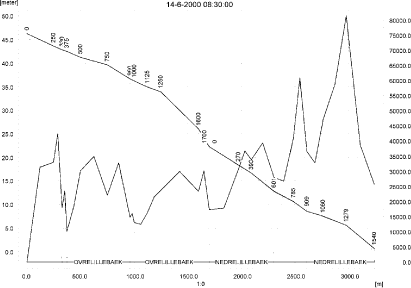
Figure 5.13. Concentrations in the sandy loam catchment on 14. June 2000, 8:30. The concentrations are generated by wind drift.
Figur 5.13. Koncentrationer i morænelersoplandet den 14. juni-2000. 8.30. Koncentrationerne genereres af drift.
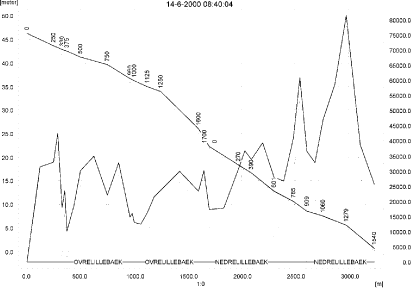
Figure 5.14. Concentrations in the sandy loam catchment on 14. June 2000, 8:40.
Figur 5.144. Koncentrationer i morænelersoplandet den 14. juni-2000. 8.40.
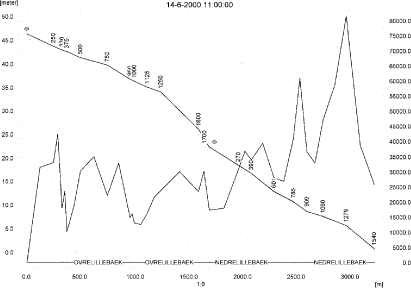
Figure 5.15. Concentrations in the sandy loam catchment on 14. June-2000, 11:00.
Figur 5.15. Koncentrationer i morænelersoplandet den 14. juni-2000. 11.00.
To be able to extract comparable values to FOCUS SW, the global maxima and time weighted concentrations (up to 7 days) were extracted when these were meaningful.
Table 5.8. Instantaneous and time weighted concentrations (ng/l) of malathion for selected points in the sandy loam catchment.
Tabel 5.8. Beregnede og tidsvægtede maximumskoncentrationer (ng/l) af malathion for udvalgte lokaliteter i morænelersoplandet.
Figure 5.16 shows the concentrations sorbed to macrophytes. The maximum concentration only reaches 5.77 µg/l, and the importance for the stream concentration appears significant but limited. The pattern follows the pattern of the water concentrations. The pore water concentration is shown in Figure 5.17. The concentration in sediment reaches 8.2 ng/kg at the upper end of the Ovrelillebaek.
Compared to the FOCUS SW-stream-scenario for D4, the concentration level in the sandy loam stream is considerably higher (81.4 µg/l compared to 3.92 µg/l). A value of 31.3 µg/l is reached already 125 m from the upstream end. The water depth at this point is between 3.6 and 4.85 cm at the time of maximum concentration. The water depth alone thus causes a factor of >7 compared to the FOCUS concentration. Furthermore, the stream does not have a square cross section as the FOCUS streams. The FOCUS D4-stream reaches a sediment concentration of 168 ng/kg while the FOCUS stream only reaches a concentration of 8 ng/kg, in spite of the much higher water concentrations.
Figure 5.19 to Figure 5.21 and Table 5.9 and Table 5.10 show the results as generated by the PestSurf templates. The maximum value generated by the templates for the upper part of the stream is 30.0 µg/l, and for the lower part, 81.4 µg/l. The maximum value generated in the upstream part of the catchment is 35.0 µg/l and in the downstream part 81.4 µg/l. Thus, the templates did catch the maximum concentration of the PestSurf simulation.
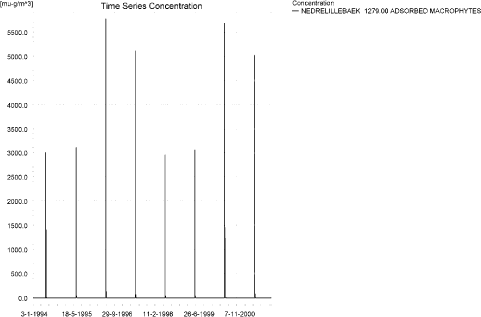
Figure 5.16. Concentration of malathion on macrophytes near the end of the sandy loam catchment. The pattern represents the whole stream.
Figur 5.16. Koncentration af malathion på makrofytter i den nedstrøms ende af morænelersoplandet. Mønsteret representerer hele åen.
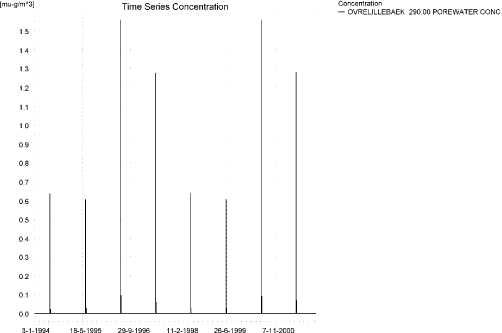
Figure 5.17. Maximum values of pore water concentration of malathion in the sandy loam catchment.
Figur 5.17. maximale værdier for porevandskoncentrationen af malathion i morænelersoplandet.
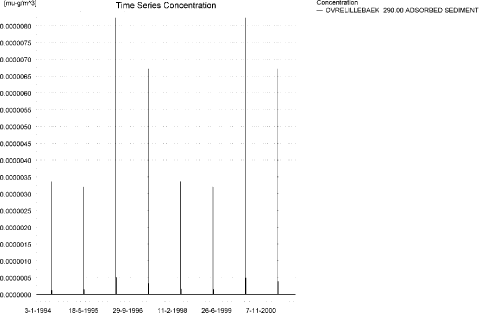
Figure 5.18. Sediment concentration of malathion in the sandy loam catchment. Note that the unit is in µg/g and not in µg/m³ as indicated.
Figur 5.18. Sedimentkoncentration af malathion i morænelersoplandet i Bemærk at enheden er µg/g sediment og ikke µg/m³ som angivet.
Click here to see Figure 5.19.
Figure 5.19. Overview for malathion in the sandy loam catchment generated by the PestSurf excel template for the upstream part of the catchment. The detection value was set to 10 ng/l.
Figur 5.19. Oversigt for malathion i morænelersoplandet genereret med PestSurf-excel-skabelonen for den opstrøms del af oplandet. Detektionsgrænsen var sat til 10 ng/l.
Click here to see Figure 5.20.
Figure 5.20. Overview for malathion in the sandy loam catchment generated by the PestSurf excel template for the upstream part of the catchment. The limiting value (in this case a toxicity value) was set to 100 ng/l. The figure to the lower right differs from Figure 5.19.
Figur 5.20. Oversigt for malathion i morænelersoplandet genereret med PestSurf-excel-skabelonen for den opstrøms del af oplandet. Grænseværdien (i dette tilfælde en toxicitetsværdi) var sat til 100 ng/l.Figuren nederst til højre er forskellig fra Figur 5.19.
Click here to see Figure 5.21.
Figure 5.21. Overview for malathion in the sandy loam catchment generated by the PestSurf excel template for the downstream part of the catchment. The detection value was set to 10 ng/l.
Figur 5.21. Oversigt for malathion i morænelersoplandet genereret med PestSurf-excel-skabelonen for den nedstrøms del af oplandet. Detektionsgrænsen var sat til 10 ng/l.
Table 5.9. Part of the result sheet generated by the PestSurf Excel sheet for the upstream part of the sandy loam catchment. The limiting values applied for generation of the table is 10 ng/l, toxicity to fish, daphnies and algae are set to 100, 1000 and 10000 ng/, respectively. The recorded peaks are shown in Figure 5.19.
Tabel 5.9. Uddrag af resultatpresentationen genereret af PestSurf-Excel-arket for den opstrøms del af morænelersoplandet. Detektionsgrænsen for tabelgenerering er sat til 10 ng/l. Toxicitetsværdierne for fisk, dafnier og alger er henholdsvis 100, 1000 og 10000 ng/l. Hændelserne er vist i Figur 5.19.
Table 5.10. Part of the result sheet generated by the PestSurf Excel sheet for the downstream part of the sandy loam catchment. The limiting values applied for generation of the table is 10 ng/l, toxicity to fish, daphnies and algae are set to 100, 1000 and 10000 ng/, respectively. The recorded peaks are shown in Figure 5.21.
Tabel 5.10. Uddrag af resultatpresentationen genereret af PestSurf-Excel-arket for den nedstrøms del af morænelersoplandet. Detektionsgrænsen for tabelgenerering er sat til 10 ng/l. Toxicitetsværdierne for fisk, dafnier og alger er henholdsvis 100, 1000 og 10000 ng/l. Hændelserne er vist i Figur 5.21.
5.4.4 Sandy loam catchment, pond
The concentration pattern is evaluated in the middle of the pond only, see Figure 5.22. The pond receives contributions through drift, in good correspondence with the fact that it is situated in the upper part of the sandy loam catchment. The maximum concentration is quite high, 655 ng/l.
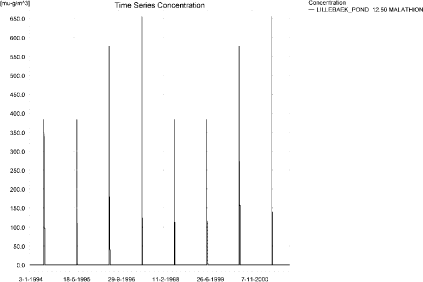
Figure 5.22. Concentrations of malathion in the sandy loam pond.
Figur 5.22. Koncentration af malathion i morænelersvandhullet.
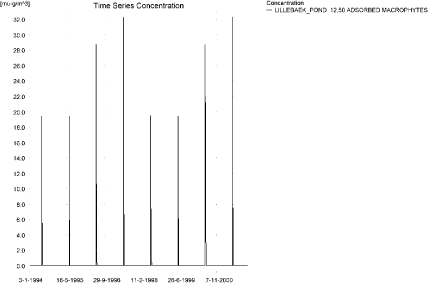
Figure 5.23. Malathion sorbed to the macrophytes in the sandy loam pond.
Figur 5.23. malathion sorberet til makrofytter i morænelers-vandhullet.
Figure 5.23 shows the concentration of malathion on macrophytes in the pond. The concentration reaches 32 ng/l, and it thus has a limited influence on the concentration in the water phase. Figure 5.24 shows the concentration of malathion in the porewater. The concentration is low, and the concentration adsorbed to sediment is <0.01 ng/kg.
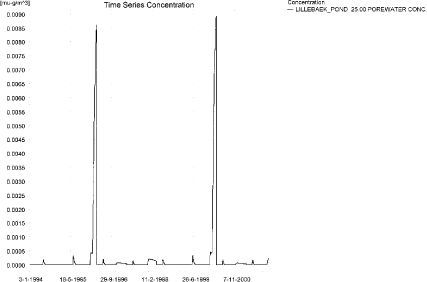
Figure 5.24. Pore water concentration of malathion in the sandy loam pond.
Figur 5.24. Porevandskoncentration af malathion i morænelersvandhullet.
In Table 5.11, global maxima and time weighted concentrations (up to 7 days) were extracted.
Table 5.11. Actual and time weighted concentrations (ng/l) of malathion in the sandy loam pond.
Tabel 5.11. Beregnede og tidsvægtede koncentrationer (ng/l) af malathion i morænelersvandhullet.
| Year | Malathion | actual | Time-weighted | Date |
| 1994 | global max | 384 | 15-06-1994 08:30 | |
| 1 hour(after max) | 355 | 367 | ||
| 1 day after sp.in. | 170 | 248 | ||
| 3 days | 101 | 163 | ||
| 4 days | 97 | 147 | ||
| 7 days | 96 | 125 | ||
| 1995 | Global max | 383 | 15-06-1995 08:30 | |
| 1 hour | 356 | 367 | ||
| 1 day | 180 | 254 | ||
| 2 days | 113 | 173 | ||
| 4 days | 110 | 157 | ||
| 7 days | 109 | 137 | ||
| 1996 | global max | 576 | 15-06-1996 08:30 | |
| 1 hour | 520 | 542 | ||
| 1 day | 221 | 335 | ||
| 2 (3*)days | 164 | 229 | ||
| 4 days | 164 | 213 | ||
| 7 (6*)days | 164 | 192 | ||
| 1997 | global max | 654 | 15-06-1997 08:30 | |
| 1 hour | 577 | 609 | ||
| 1 day | 181 | 327 | ||
| 2 (3*)days | 123 | 199 | ||
| 4 days | 123 | 180 | ||
| 7 (6*)days | 123 | 155 | ||
| 1998 | global max | 384 | 14-06-1998 08:30 | |
| 1 hour | 356 | 367 | ||
| 1 day | 182 | 256 | ||
| 2 (3*)days | 116 | 175 | ||
| 4 days | 112 | 160 | ||
| 7 (6*)days | 112 | 139 | ||
| 1999 | global max | 384 | 14-06-1999 08:30 | |
| 1 hour | 356 | 367 | ||
| 1 day | 183 | 256 | ||
| 2 (3*)days | 117 | 176 | ||
| 4 days | 113 | 161 | ||
| 7 (6*)days | 113 | 140 | ||
| 2000 | global max | 577 | 14-06-2000 08:30 | |
| 1 hour | 519 | 542 | ||
| 1 day | 216 | 332 | ||
| 2 (3*)days | 157 | 224 | ||
| 4 days | 157 | 207 | ||
| 7 (6*)days | 158 | 186 | ||
| 2001 | global max | 655 | 14-06-2001 08:30 | |
| 1 hour | 579 | 610 | ||
| 1 day | 195 | 336 | ||
| 2 (3*)days | 138 | 212 | ||
| 4 days | 138 | 193 | ||
| 7 (6*)days | 139 | 170 | ||
| max values | ||||
| global max | ||||
| 1 hour | 655 | |||
| 1 day | 579 | 610 | ||
| 2 days | 221 | 336 | ||
| 4 days | 164 | 229 | ||
| 7 days | 164 | 213 |
Figure 5.25 and Table 5.12 show output from the PestSurf template, with a time series identical to Figure 5.22.
The FOCUS SW-scenario D4-pond generates a concentration of 0.187 µg/l, which is somewhat lower than the PestSurf sandy loam pond-concentration of 0.655 µg/l. Important reasons for the difference is the higher exposure of the PestSurf compared to the FOCUS SW D4-pond, and the water level at the time of spraying. The concentration in the sediment is lower than the value calculated by FOCUS SW for the D4-pond.
Click here to see Figure 5.25.
Figure 5.25. Overview for malathion in the sandy loam pond generated by the PestSurf excel template. The time series shown is identical to the one in Figure 5.22. The detection limit used in 1 ng/l.
Figur 5.25. Oversigt for malathion i morænelersoplandet genereret med PestSurf-excel-skabelonen. Den viste tidsserie er mage til den i Figur 5.22. Detektionsgrænsen er sat til 1 ng/l.
Table 5.12. Part of the result sheet generated by the PestSurf Excel sheet. The lowest detection valuε = 1 ng/l, toxicity to fish, daphnies and algae are set to 10, 100 and 1000 ng/, respectively. The recorded peaks are shown in Figure 5.25.
Tabel 5.12. Uddrag af resultatpresentationen genereret af PestSurf-Excel-arket. Detektionsgrænsen er sat til 1 ng/l. Toxicitetsværdierne for fisk, dafnier og alger er henholdsvis 10, 100 og 1000 ng/l. De tabellerede hændelser er vist i Figur 5.25.
Table 5.13. Summary of simulation results for malathion.
Tabel 5.13. Opsummerede resultater for malathion.
5.5 Summary of simulations
The maximum actual concentrations for all simulations are recorded in Table 5.13. For malathion, the mechanism generating the maximum concentrations is drift in all instances. The concentrations generated for the sandy pond is smaller than the concentration generated for the D3 ditch, which again is smaller than the concentration in the sandy stream. The reason for the high exposure for the sandy stream is the accumulation of wind drift over a long stretch of the stream. 112 m from the upstream end, the maximum concentration generated is 1.96 µg/l, a value that is much more comparable to the concentration in the D3 ditch (4.61 µg/l). The values are not directly comparable as the sandy stream is protected by a 20 m buffer zone along the stretch. The value is thus a combination of a reduced drift dose (a factor of 14.7) and a water depth of 7 cm.
The concentration in the sandy loam pond is higher than in the D4-pond due to its higher exposure and a water depth of about 70-cm at the time of spraying.
Compared to the FOCUS SW-stream-scenario for D4, the concentration level in the sandy loam stream is considerably higher (81.4 µg/l compared to 3.92 µg/l). A value of 31.3 µg/l is reached already 125 m from the upstream end. The water depth at this point is between 3.6 and 4.85 cm at the time of maximum concentration. The water depth alone thus causes a factor of >7 compared to the FOCUS concentration. Furthermore, the PestSurf stream does not have a square cross section as the FOCUS streams. The cross section at the upstream end are triangular. The maximum concentration reached on the streach 500 m to 1700 m from the upstream end is 35.0 µg/l, 625 m from the upstream end.
The FOCUS D4-stream reaches a sediment concentration of 168 ng/kg while the PestSurf sandy loam stream only reaches a concentration of 8 ng/kg, in spite of the much higher water concentrations.
Macrophytes have a limited influence on the concentration in the water phase.
Version 1.0 December 2006, © Danish Environmental Protection Agency